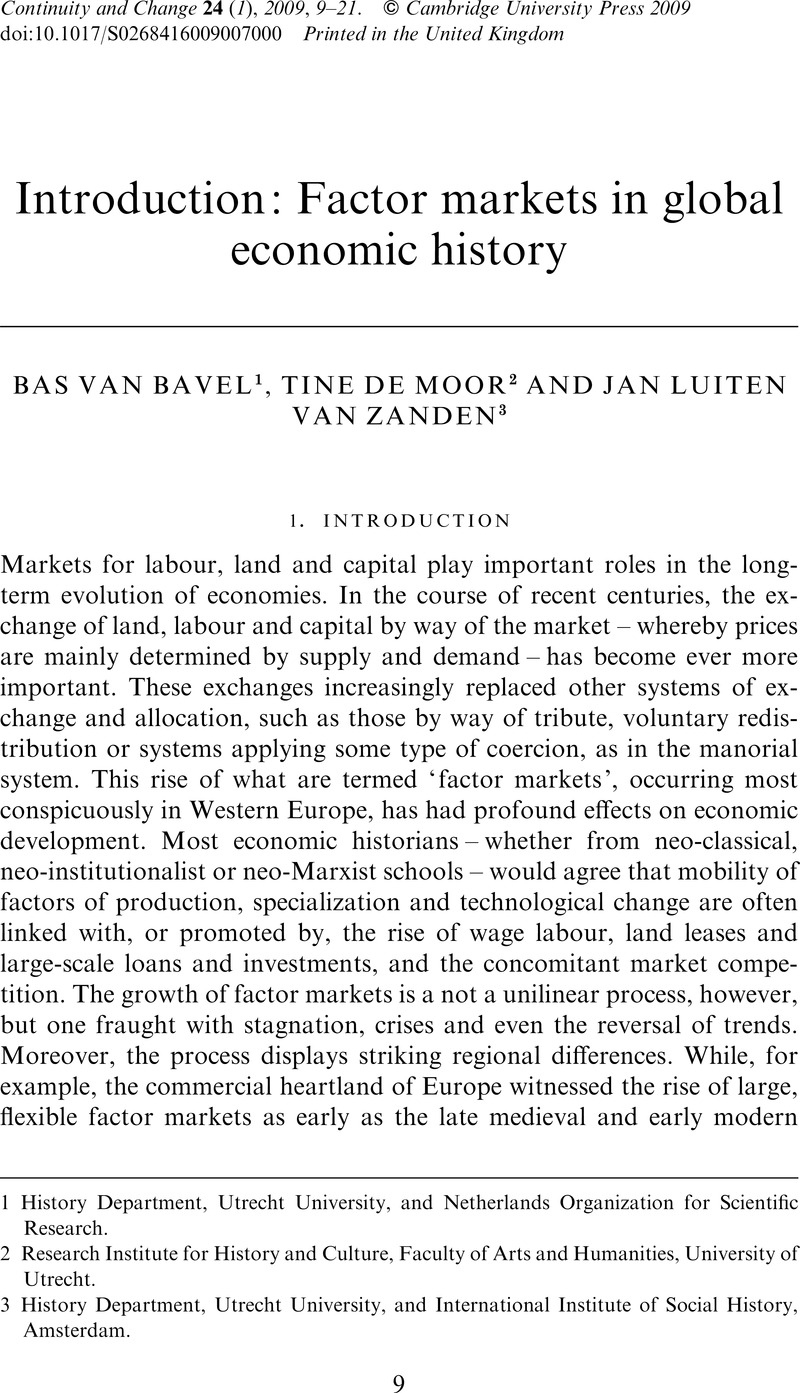Article contents
Introduction: Factor markets in global economic history
Published online by Cambridge University Press: 20 April 2009
Abstract

- Type
- Research Article
- Information
- Continuity and Change , Volume 24 , Special Issue 1: FACTOR MARKETS IN GLOBAL ECONOMIC HISTORY , May 2009 , pp. 9 - 21
- Copyright
- Copyright © Cambridge University Press 2009
References
ENDNOTES
1 On this divergence see Pritchett, L., ‘Divergence, big time’, Journal of Economic Perspectives 11 (1997), 3–17CrossRefGoogle Scholar, and Bourguignon, F. and Morrison, C., ‘Inequality among world citizens, 1820–1992’, American Economic Review 92 (2002), 727–44.CrossRefGoogle Scholar
2 K. Pomeranz, The Great Divergence: China, Europe, and the making of the modern world economy (Princeton, 2000), 69–107.
3 The articles on the land market presented at this conference (by Bas van Bavel, Markus Cerman and Ken Pomeranz) have been published previously, in Continuity and Change 23, 1 (2008). We should like to thank the Leverhulme Trust for supporting the Global Economy History Network (GEHN) and the organization of the Utrecht conference.
4 D. C. North, Institutions, institutional change and economic performance (Cambridge, 1990), and H. de Soto, The mystery of capital: why capitalism triumphs in the West and fails everywhere else (New York, 2003).
5 P. A. Hall and D. Soskice eds., Varieties of capitalism: the institutional foundations of comparative advantage (Oxford, 2001).
6 See also J. R. Hollingsworth and R. Boyer eds., Contemporary capitalism: the embeddedness of institutions (Cambridge, 1997).
7 Much more than in his earlier work, the notion that bad institutions often persist is manifest in North's 1990 Institutions, institutional change and economic performance. See also S. L. Engerman and K. L. Sokoloff, ‘Factor endowments, institutions and differential paths of growth among New World economies: a view from economic historians of the United States’, in S. Haber ed., How Latin America fell behind: essays in the economic histories of Brazil and Mexico, 1800–1914 (Stanford, 1997), stressing the interaction between the persistence of bad institutions and inequality.
8 Bourguignon, F. and Verdier, T., ‘Oligarchy, democracy, inequality and growth’, Journal of Development Economics 62 (2000), 285–313CrossRefGoogle Scholar. See also Persson, T. and Tabellini, G., ‘Is inequality harmful for growth?’, American Economic Review 84 (1994), 600–21.Google Scholar
9 North, D. C. and Weingast, B. R., ‘Constitutions and commitment: the evolution of institutions governing public choice in seventeenth-century England’, Journal of Economic History 49 (1989), 803–32CrossRefGoogle Scholar. For the late Middle Ages see J. Zuijderduijn, ‘Medieval capital markets: markets for rents between state formation and private investment in Holland (1300–1550)’ (unpublished PhD thesis, Utrecht University, 2007).
10 Campbell, B. M. S., ‘The agrarian problem in the early fourteenth century’, Past and Present 188 (2005), 3–70CrossRefGoogle Scholar; Vanhaute, E., ‘Rich agriculture and poor farmers: land, landlords and farmers in Flanders in the eighteenth and nineteenth centuries’, Rural History 12 (2001), 19–40.CrossRefGoogle ScholarPubMed
11 G. Clark, A farewell to alms: a brief economic history of the world (Princeton, 2007), 167–75, and S. R. Epstein, Freedom and growth: the rise of states and markets in Europe, 1300–1750 (London, 2000).
12 C. Dyer, Standards of living in the later Middle Ages: social change in England, c. 1200–1520 (Cambridge, 1989), 211–14, and van Bavel, B. J. P., ‘Rural wage labour in the sixteenth-century Low Countries: an assessment of the importance and nature of wage labour in the countryside of Holland, Guelders and Flanders’, Continuity and Change 21, 1 (2005), 37–72.CrossRefGoogle Scholar
13 van Bavel, B. J. P., ‘The organization and rise of land and lease markets in northwestern Europe and Italy, c. 1000–1800’, Continuity and Change 23, 1 (2008), 13–53.CrossRefGoogle Scholar
14 O. Saito and T. Settsu, ‘Factor markets and their institutions in traditional Japan: a note on capital markets’, paper presented at the GEHN/UU conference on ‘The rise, organization, and institutional framework of factor markets’ (2005), available at http://www.iisg.nl/hpw/factormarkets-intro.php.
15 T. De Moor and J. L. van Zanden, ‘Girlpower: the European Marriage Pattern (EMP) and labour markets in the North Sea region in the late medieval and early modern period’, paper presented at the GEHN/UU conference on ‘The rise, organization, and institutional framework of factor markets’ (2005) (see note 14 above).
16 R. H. Britnell, ‘Commercialisation and economic development in England, 1000–1300’, in R. H. Britnell and B. M. S. Campbell eds., A commercialising economy: England 1086 to c. 1300 (Manchester and New York, 1995), 7–26.
17 See also R. H. Britnell, The commercialisation of English society, 1000–1500 (Cambridge, 1993), 81–97.
18 See A. Hayami, ‘Introduction’, in The economic history of Japan: 1600–1990, vol. I: Emergence of economic society in Japan 1600–1859, ed. Y. Hayami, O. Saito and R. P. Toby (Oxford, 2004), 1–36; C. Moll-Murata, ‘Working for the state: the Chinese labour market for manufacture and construction, 1000–1900’, article presented at the GEHN/UU conference on ‘The rise, organization, and institutional framework of factor markets (2005) (see note 14, above).
19 P. Bonnassie, From slavery to feudalism in south-western Europe (Cambridge, 1991); P. Dockès, Medieval slavery and liberation (Chicago, 1982).
- 8
- Cited by


